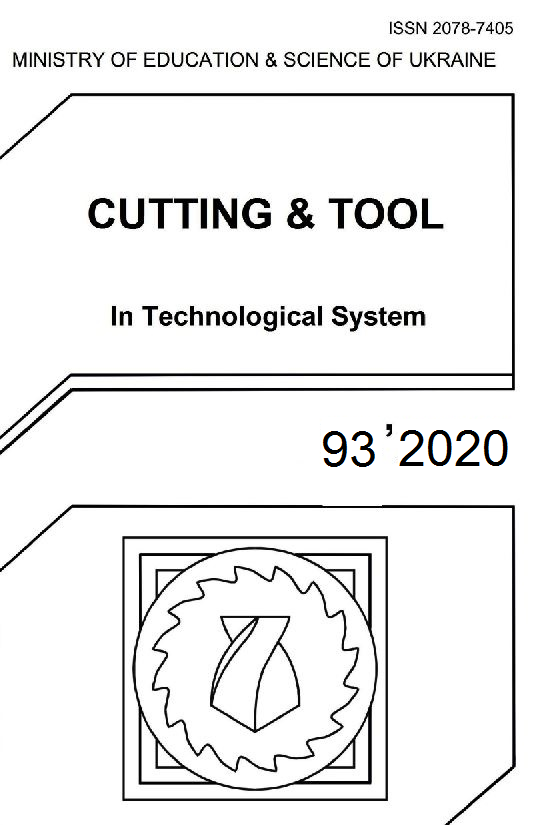MODELING OF CUTTING TOOLS WEAR FOR LATHES
DOI:
https://doi.org/10.20998/2078-7405.2020.93.15Keywords:
wear, contact stress, cutting edge, cutting temperature, , adhesive wear, the adequacy of the models.Abstract
A mathematical model to estimate the average number of parts, processing which is possible to achieve the criterion of maximum allowable wear on the back of the cutter heavy lathe, and the maximum allowable amount of tool material, removed from the front surface of the tool. Experimental equipment for measuring tool wear has been developed. Insert wear curves derived from industrial test results. Confirmation of the adequacy of the models of the instrument gives a possibility of their adjustment to the basic criteria of their dullness.References
Palanisamy, Ponnusamy & Shanmugasundaram, S. (2008). Modelling of tool wear and surface roughness in hard turning using regression and artificial neural network. International Journal of Machining and Machinability of Materials. 4. 10.1504/IJMMM.2008.020912.
Čerče, L., Pušavec, F., & Kopač, J. (2015). A New Approach to Spatial Tool Wear Analysis and Monitoring. Strojniški vestnik - Journal of Mechanical Engineering, 61(9), 489-497. doi: http://dx.doi.org/10.5545/sv-jme.2015.2512.
P. Huang and W. B. Lee, “Cutting Force Prediction for Ultra-Precision Diamond Turning by Considering the Effect of Tool Edge Radius,” International Journal of Machine Tools and Manufacture 109 (October 2016): 1–7, https://doi.org/10.1016/j.ijmachtools.2016.06.005.
Zhang X, Zheng G, Cheng X, Xu R, Zhao G, Tian Y. Fractal Characteristics of Chip Morphology and Tool Wear in High-Speed Turning of Iron-Based Super Alloy. Materials (Basel). 2020;13(4):1020. Published 2020 Feb 24. doi:10.3390/ma13041020.
Maruda R.W., Krolczyk G.M., Nieslony P., Wojciechowski S., Michalski M., Legutko S. The influence of the cooling conditions on the cutting tool wear and the chip formation mechanism. J. Manuf. Process. 2016;24:107–115. doi: 10.1016/j.jmapro.2016.08.006. [CrossRef] [Google Scholar].
Hao Z.P., Fan Y.H., Lin J.Q., Yu Z.X. Wear characteristics and wear control method of PVD-coated carbide tool in turning Inconel 718. Int. J. Adv. Manuf. Technol. 2015;78:1329–1336. doi: 10.1007/s00170-014-6752-0. [CrossRef] [Google Scholar].
Downloads
Published
Issue
Section
License
Copyright Notice
Authors who publish with this Collection agree to the following terms:
1. Authors retain copyright and grant the Collection right of first publication with the work simultaneously licensed under a Creative Commons Attribution License that allows others to share the work with an acknowledgement of the work's authorship and initial publication in this Collection.
2. Authors are able to enter into separate, additional contractual arrangements for the non-exclusive distribution of the Collection's published version of the work (e.g., post it to an institutional repository or publish it in a book), with an acknowledgement of its initial publication in this Collection.
3. Authors are permitted and encouraged to post their work online (e.g., in institutional repositories or on their website) prior to and during the submission process, as it can lead to productive exchanges, as well as earlier and greater citation of published work.

